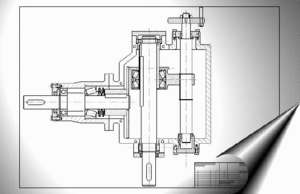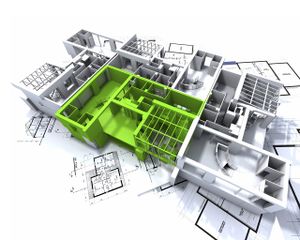CAD Drafting
Computer Aided Design Drafting or Computer-aided design (CAD),also known as computer-aided drafting (CAD) is the use of computer systems to assist in the creation, modification, analysis, or optimization of a design.Computer aided design drafting describes the process of creating a technical drawing with the use of computer software.CAD software is used to increase the productivity of the designer, improve the quality of design, improve communications through documentation, and to create a database for manufacturing.CAD output is often in the form of electronic files for print or machining operations. CAD software uses either vector based graphics to depict the objects of traditional drafting, or may also produce raster graphics showing the overall appearance of designed objects. CAD often involves more than just shapes. As in the manual drafting of technical and engineering drawings, the output of CAD must convey information, such as materials, processes, dimensions, and tolerances, according to application-specific conventions. CAD may be used to design curves and figures in two-dimensional (2D) space; or curves, surfaces, and solids in three-dimensional (3D) space.
CAD is an important industrial art extensively used in many applications, including automotive, shipbuilding, and aerospace industries, industrial and architectural design, prosthetics, and many more. CAD is also widely used to produce computer animation for special effects in movies, advertising and technical manuals. The modern ubiquity and power of computers means that even perfume bottles and shampoo dispensers are designed using techniques unheard of by engineers of the 1960s. Because of its enormous economic importance, CAD has been a major driving force for research in computational geometry, computer graphics (both hardware and software), and discrete differential geometry. The design of geometric models for object shapes, in particular, is occasionally called computer-aided geometric design (CAGD).
While the goal of automated CAD systems is to increase efficiency, they are not necessarily the best way to allow newcomers to understand the geometrical principles of Solid Modeling. For this, scripting languages such as PLaSM (Programming Language of Solid Modeling) are more suitable.
Uses
Computer aided design drafting is one of the many tools used by engineers and designers and is used in many ways depending on the profession of the user and the type of software in question. CAD is one part of the whole Digital Product Development (DPD) activity within the Product Lifecycle Management (PLM) processes, and as such is used together with other tools, which are either integrated modules or stand-alone products, such as:
- Computer-aided engineering (CAE) and Finite element analysis (FEA)
- Computer-aided manufacturing (CAM) including instructions to Computer Numerical Control (CNC) machines
- Photo realistic rendering
- Document management and revision control using Product Data Management (PDM).
CAD is also used for the accurate creation of photo simulations that are often required in the preparation of Environmental Impact Reports, in which computer aided design drafting of intended buildings are superimposed into photographs of existing environments to represent what that locale will be like were the proposed facilities allowed to be built. Potential blockage of view corridors and shadow studies are also frequently analyzed through the use of CAD.
CAD has been proven to be useful to engineers as well. Using four properties which are history, features, parameterization, and high level constraints. The construction history can be used to look back into the model's personal features and work on the single area rather than the whole model. Parameters and constraints can be used to determine the size, shape, and the different modeling elements. The features in the CAD system can be used for the variety of tools for measurement such as tensile strength, yield strength, also its stress and strain and how the element gets affected in certain temperatures.
Types
There are several different types of CAD,each requiring the operator to think differently about how to use them and design their virtual components in a different manner for each. There are many producers of the lower-end 2D systems, including a number of free and open source programs. These provide an approach to the drawing process without all the fuss over scale and placement on the drawing sheet that accompanied hand drafting, since these can be adjusted as required during the creation of the final draft.
3D wireframe is basically an extension of 2D drafting . Each line has to be manually inserted into the drawing. The final product has no mass properties associated with it and cannot have features directly added to it, such as holes. The operator approaches these in a similar fashion to the 2D systems, although many 3D systems allow using the wireframe model to make the final engineering drawing views.
3D dumb solids are created in a way analogous to manipulations of real world objects . Basic three-dimensional geometric forms (prisms, cylinders, spheres, and so on) have solid volumes added or subtracted from them, as if assembling or cutting real-world objects. Two-dimensional projected views can easily be generated from the models. Basic 3D solids don't usually include tools to easily allow motion of components, set limits to their motion, or identify interference between components.
3D parametric solid modeling requires the operator to use what is referred to as design intent. The objects and features created are adjustable. Any future modifications will be simple, difficult, or nearly impossible, depending on how the original part was created. One must think of this as being a perfect world representation of the component. If a feature was intended to be located from the center of the part, the operator needs to locate it from the center of the model, not, perhaps, from a more convenient edge or an arbitrary point, as he could when using dumb solids. Parametric solids require the operator to consider the consequences of his actions carefully.
Some software packages provide the ability to edit parametric and non-parametric geometry without the need to understand or undo the design intent history of the geometry by use of direct modeling functionality. This ability may also include the additional ability to infer the correct relationships between selected geometry (e.g., tangency, concentricity) which makes the editing process less time and labor intensive while still freeing the engineer from the burden of understanding the models. These kind of non-history based systems are called Explicit Modellers or Direct CAD Modelers.
Top end systems offer the capabilities to incorporate more organic, aesthetics and ergonomic features into designs. Freeform surface modeling is often combined with solids to allow the designer to create products that fit the human form and visual requirements as well as they interface with the machine.
Technology
Originally software for computer aided design drafting was developed with computer languages such as Fortran, but with the advancement of object-oriented programming methods this has radically changed. Typical modern parametric feature based modeler and freeform surface systems are built around a number of key C modules with their ownAPIs. A CAD system can be seen as built up from the interaction of a graphical user interface (GUI) with NURBS geometry and/or boundary representation (B-rep) data via a geometric modeling kernel. A geometry constraint engine may also be employed to manage the associative relationships between geometry, such as wireframe geometry in a sketch or components in an assembly.
Unexpected capabilities of these associative relationships have led to a new form of prototyping called digital prototyping. In contrast to physical prototypes, which entail manufacturing time in the design. That said, CAD models can be generated by a computer after the physical prototype has been scanned using an industrial CT scanning machine. Depending on the nature of the business, digital or physical prototypes can be initially chosen according to specific needs.
Today, CAD systems exist for all the major platforms (Windows, Linux, UNIX and Mac OS X); some packages even support multiple platforms.Right now, no special hardware is required for most CAD software. However, some CAD systems can do graphically and computationally intensive tasks, so a modern graphics card, high speed (and possibly multiple) CPUs and large amounts of RAM may be recommended.
The human-machine interface is generally via a computer mouse but can also be via a pen and digitizing graphics tablet. Manipulation of the view of the model on the screen is also sometimes done with the use of a Spacemouse/SpaceBall. Some systems also support stereoscopic glasses for viewing the 3D model.

